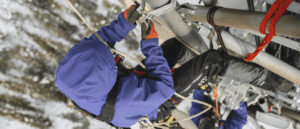It Is Time For The Superload

Photo: Pennsylvania Department of Transportation
We’ve all seen oversize loads on the highway. They’re usually pre-manufactured buildings or wind turbine parts, but I would guess that you have never seen a superload. And maybe not one that takes up two lanes, slowly meandering to its destination. Such a load is currently making its way through Pennsylvania.
It started in West Milford, New York last week, when the truck set off, and made its way into Pennsylvania this week. Its destination is Wampum, Pennsylvania, in the western part of the state. It’s carrying a massive radioactive tank from a nuclear site that was formerly used to train Navy sailors, according to The New York Times. The tank will eventually be taken apart, but not before the journey, which is expected to be done on January 21.
The truck’s speed limit is 30 mph, according to the Pennsylvania Department of Transportation, or lower, depending on the street limits. It will do most of its moving at night to limit disruptions to traffic and will only be passable when escort vehicles stop it along the road to let cars through. If you’re driving in the middle of the night in Pennsylvania for the next week, in other words, check traffic before you go.
In Pennsylvania, the truck started on Interstate 81 south and will eventually get on to Interstate 80, on which it will traverse a big chunk of the state, before getting on to a complicated series of other roads, going into Ohio for a hot minute, then coming back into Pennsylvania and finally reaching its destination. (You can see the full route here.)
The NYT quoted a trucker who is impressed:
Lew Grill, a truck-driving expert and instructor in Montana with 54 years’ experience on the road, said he had deep respect for any truck driver who could haul a 294-ton load.
He said the weight limit for the average tractor-trailer is 40 tons, featherweight by comparison.
“This is phenomenal,” Mr. Grill said. “If this guy pulls this off professionally, he should get accolades. We should bow to him. There are not many drivers like this.”
Mr. Grill said the driver will need to respond to unforeseen challenges, like cars stopped on the side of the road.
Superloads are a specialty for Perkins STC, the company doing the trucking. In 2018, they carried seven 318-ton engines across a part of Michigan, in a project that sounds as intense.
From Perkins’ website, which I will quote here at length because all of this is fascinating:
The trailer was configured to accommodate a top-down load maneuver allowing a crane to place the cargo between the suspension beams from above and secure onto customized load support beams below. This combination allowed Perkins to optimize loaded travel height and reduce the overall schedule by eliminating the need to disassemble and reassemble the trailer at both sites. In order to further minimize costs and time, the trailer, which was disassembled after a test fit and trial run in Minnesota was put onto thirteen (13) flatbeds both oversize and legal flatbeds for mobilization to L’Anse, MI. Fortunately for the customer and us, the empty trailer was approved to travel back to the load site fully assembled at night once unloaded to reduce the need to disassemble back onto flatbeds and start over.
The route was pretty straight forward, as there weren’t many options to choose from. It was a straight shot on one state and one county highway to travel from L’anse, MI to Eagle Mills, MI for a total of 61 miles. Night moves always add a significant amount of additional support due to the fact that we were 391’ long, 22’ wide, and 19’ high. We traveled from 10pm to 4am every night for three to four days to maintain a streamlined schedule of loading, traveling in one day and unloading and traveling back the next. It was definitely not easy to maintain this schedule for an extended period of time, but we had a rotation of drivers and crew, which allowed us to meet the demands of the schedule without risking safety.
The route included curves, bridges, hills, turns, one roundabout, and more wires and intersections than we could count. Along with the Perkins teams, there were several other crews who made this job successful considering all those factors. The Michigan State Patrol was escorting us each night with a minimum of two officers to help re-route traffic or block off intersections until we passed. Our customer, Vic’s Crane & Rigging, out of Rosemount, MN, provided all the crane and rigging support for the entire project along with transportation from the port to the laydown site. The entourage of bucket truck and utility companies was impressive for this job, as there were cable, electric, and other wires that had to be lifted along the route, as well as traffic lights and signs that needed to be moved for the safety of the cargo. The permitting authority approving our trailer, our routes, and our job was no small feat either. Perkins submitted feasibility studies for our customer, which ended up being used to help prove that we were capable of these types of coordinated moves. Turn studies were submitted, along with engineered drawings illustrating how to maneuver the roundabout, which is always a concern along any route.
The job itself took about 250 man days with ten (10) Perkins team members working for three and a half weeks straight with upwards of an additional 100 days spent running route surveys, meeting with roadway officials and buttoning up any surprises that could interfere with the success of the project. The whole project was a year and a half in the making with four months focused on getting the approvals, third party support, and trained professionals we needed.
It sounds like working at Perkins would be cool, spending your time planning and moving superloads. Then you could tell your friends what you do is, you plan and move superloads.





